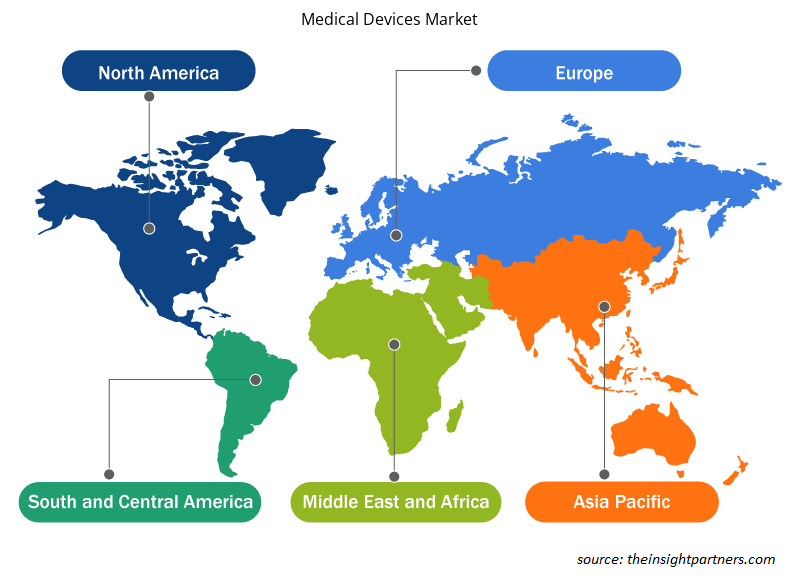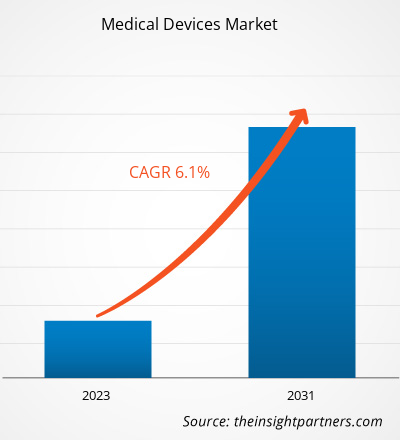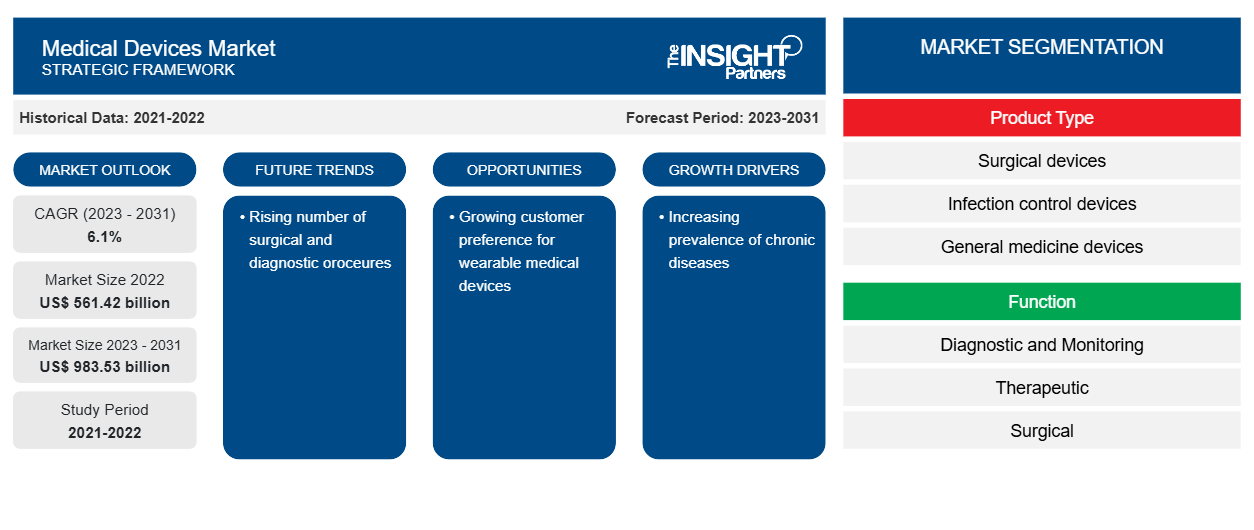Se proyecta que el tamaño del mercado de dispositivos médicos alcance los 983,53 mil millones de dólares estadounidenses para 2031 desde los 561,42 mil millones de dólares estadounidenses en 2022. Se espera que el mercado registre una CAGR del 6,1 % en 2023-2031.
Es probable que la creciente prevalencia de enfermedades crónicas, el aumento de la población de edad avanzada propensa a varias enfermedades crónicas y los avances tecnológicos relacionados con los dispositivos médicos sigan siendo tendencias clave del mercado de dispositivos médicos.
Análisis del mercado de dispositivos médicos
La detección temprana de enfermedades y afecciones médicas crónicas y agudas, el aumento de la población geriátrica y el rápido desarrollo de dispositivos médicos avanzados están creciendo significativamente a nivel mundial, lo que resulta en una mayor demanda de pacientes que requieren intervención y tratamiento médicos. Este factor ha resultado además en la demanda de dispositivos médicos que respalden la gestión, el diagnóstico y el tratamiento de enfermedades. Las enfermedades crónicas como el cáncer, las enfermedades cardiovasculares, la diabetes y los trastornos respiratorios han aumentado a nivel mundial. Por ejemplo, según el artículo publicado en A Cancer Journal for Clinicians en 2023, en 2023, se proyecta que ocurrirán aproximadamente 1.958.310 nuevos casos de cáncer y 609.820 muertes por cáncer en los Estados Unidos. Para el tratamiento de enfermedades crónicas, se requiere un monitoreo y manejo continuos con dispositivos médicos como monitores de glucosa, monitores de presión arterial y equipos de terapia respiratoria, lo que a su vez está impulsando el mercado en general.
Descripción general del mercado de dispositivos médicos
América del Norte es el mercado más grande para el crecimiento del mercado de dispositivos médicos, y Estados Unidos tiene la mayor participación de mercado, seguido de Canadá. El creciente envejecimiento de la población ha dado lugar a enfermedades y afecciones relacionadas con la edad, que requieren dispositivos médicos como audífonos , reemplazos de articulaciones y dispositivos de asistencia, lo que se prevé que impulse aún más el mercado general de dispositivos médicos de América del Norte. Se espera que esta creciente prevalencia de enfermedades impulse el crecimiento del mercado de dispositivos médicos durante el período de pronóstico. La población geriátrica es más propensa a contraer enfermedades relacionadas con la edad que se observan menos prevalentes entre las personas más jóvenes. Por ejemplo, según los datos publicados en NCBI en 2022, la prevalencia general autoinformada de enfermedades cardiovasculares (ECV) en la población mayor de 45 años y más fue del 29,4%. De manera similar, la tasa de prevalencia aumentó con la edad, del 22% en el grupo de edad de 45 a 54 años al 38% en el grupo de edad de 70 años o más, lo que indica que la población geriátrica tiene un alto riesgo de desarrollar ECV. Por lo tanto, la creciente población geriátrica en América del Norte está impulsando el mercado en general.
Personalice este informe según sus necesidades
Obtendrá personalización en cualquier informe, sin cargo, incluidas partes de este informe o análisis a nivel de país, paquete de datos de Excel, así como también grandes ofertas y descuentos para empresas emergentes y universidades.
-
Obtenga las principales tendencias clave del mercado de este informe.Esta muestra GRATUITA incluirá análisis de datos, desde tendencias del mercado hasta estimaciones y pronósticos.
Factores impulsores y oportunidades del mercado de dispositivos médicos
La creciente prevalencia de enfermedades crónicas demanda dispositivos médicos que favorecen el mercado
La creciente carga de enfermedades crónicas a nivel mundial está impulsando la demanda de dispositivos médicos y servicios de tratamiento que involucran procedimientos quirúrgicos y de diagnóstico. Por ejemplo, según las estadísticas de 2022 publicadas por la IDF, aproximadamente 2,9 millones de personas sobrevivían con diabetes en Canadá en 2021. Se proyecta que esta cifra alcance los 3,2 millones y los 3,4 millones en 2030 y 2045, respectivamente. Por lo tanto, se espera que el aumento en el número de personas que padecen diabetes aumente la demanda de diversos dispositivos médicos portátiles y ponibles.
Avances tecnológicos en dispositivos médicos: una oportunidad en el mercado de dispositivos médicos
El creciente interés por fabricar dispositivos médicos tecnológicamente avanzados y el aumento de los lanzamientos de productos relacionados con los dispositivos médicos están contribuyendo al crecimiento del mercado. Por ejemplo, en abril de 2022, Medline UNITE lanzó el sistema de placas para fracturas de calcáneo y el implante intraperitoneal de peroné. El sistema proporciona un sistema de titanio para traumatismos de pie y tobillo para abordar casi todas las fracturas que requieren reducción abierta y fijación interna (ORIF) con fijación con placa y tornillos.
Informe de mercado de dispositivos médicos Análisis de segmentación
Los segmentos clave que contribuyeron a la derivación del análisis del mercado de dispositivos médicos son los servicios, los proveedores de servicios y los usuarios finales.
- Según el producto, el mercado de dispositivos médicos se segmenta en dispositivos quirúrgicos, dispositivos de diagnóstico in vitro, dispositivos de medicina general, dispositivos de endoscopia, dispositivos de control de infecciones, oftalmología, endoscopia, neurología y otros. El segmento IVD tuvo una mayor participación de mercado en 2023.
- Por función, el mercado está segmentado en Diagnóstico y Monitoreo, Terapéutico, Quirúrgico y Otros. El segmento de diagnóstico y monitoreo tuvo la mayor participación del mercado en 2023. Sin embargo, se espera que el segmento quirúrgico registre la CAGR más alta durante el período de pronóstico.
- Por usuario final, el mercado está segmentado en hospitales y clínicas, centros quirúrgicos ambulatorios y otros. El segmento de hospitales tuvo la mayor participación de mercado en el año 2023 y la CAGR más alta durante el período de pronóstico.
Análisis de la cuota de mercado de dispositivos médicos por geografía
El alcance geográfico del informe del mercado de dispositivos médicos se divide principalmente en cinco regiones: América del Norte, Asia Pacífico, Europa, Medio Oriente y África, y América del Sur / América del Sur y Central.
América del Norte ha dominado el mercado de dispositivos médicos. El crecimiento del mercado se puede atribuir a la creciente adopción de dispositivos médicos por parte de los centros de atención médica, la creciente carga de enfermedades crónicas, los altos gastos de atención médica y la presencia de importantes fabricantes de dispositivos médicos en los países de América del Norte.
Noticias y desarrollos recientes del mercado de dispositivos médicos
El mercado de dispositivos médicos se evalúa mediante la recopilación de datos cualitativos y cuantitativos posteriores a la investigación primaria y secundaria, que incluye publicaciones corporativas importantes, datos de asociaciones y bases de datos. A continuación, se incluye una lista de los avances en el mercado de los trastornos del habla y el lenguaje y las estrategias:
- Max Ventilator amplió su nicho con el lanzamiento de dispositivos inteligentes, entre ellos oxímetros de pulso , electrocardiógrafos y monitores. El dispositivo médico ofrece soluciones que ofrecen una calidad de primera clase a un costo asequible. (Fuente: Max Ventilator, comunicado de prensa/sitio web de la empresa/boletín informativo, abril de 2023)
- Stryker lanzó su sistema de compresión dinámica EasyFuse. Creado con nitinol, un metal de aleación de níquel y titanio conocido por su resistencia y recuperación de la forma, el nuevo sistema de grapas para pie y tobillo de Stryker está diseñado para disminuir la complejidad quirúrgica, proporcionar implantes de compresión dinámica resistentes y reducir los desechos en el quirófano. (Fuente: Stryker, comunicado de prensa/sitio web de la empresa/boletín informativo, mayo de 2022)
Perspectivas regionales del mercado de dispositivos médicos
Los analistas de Insight Partners explicaron en detalle las tendencias y los factores regionales que influyen en el mercado de dispositivos médicos durante el período de pronóstico. Esta sección también analiza los segmentos y la geografía del mercado de dispositivos médicos en América del Norte, Europa, Asia Pacífico, Oriente Medio y África, y América del Sur y Central.

- Obtenga datos regionales específicos para el mercado de dispositivos médicos
Alcance del informe sobre el mercado de dispositivos médicos
| Atributo del informe | Detalles |
|---|---|
| Tamaño del mercado en 2022 | US$ 561.42 mil millones |
| Tamaño del mercado en 2031 | US$ 983,53 mil millones |
| CAGR global (2023 - 2031) | 6,1% |
| Datos históricos | 2021-2022 |
| Período de pronóstico | 2023-2031 |
| Segmentos cubiertos |
Por tipo de producto
|
| Regiones y países cubiertos |
América del norte
|
| Líderes del mercado y perfiles de empresas clave |
|
Densidad de actores del mercado de dispositivos médicos: comprensión de su impacto en la dinámica empresarial
El mercado de dispositivos médicos está creciendo rápidamente, impulsado por la creciente demanda de los usuarios finales debido a factores como la evolución de las preferencias de los consumidores, los avances tecnológicos y una mayor conciencia de los beneficios del producto. A medida que aumenta la demanda, las empresas amplían sus ofertas, innovan para satisfacer las necesidades de los consumidores y aprovechan las tendencias emergentes, lo que impulsa aún más el crecimiento del mercado.
La densidad de actores del mercado se refiere a la distribución de las empresas o firmas que operan dentro de un mercado o industria en particular. Indica cuántos competidores (actores del mercado) están presentes en un espacio de mercado determinado en relación con su tamaño o valor total de mercado.
Las principales empresas que operan en el mercado de dispositivos médicos son:
- Medtronic plc,
- Abad
- Boston Scientific y Corporación,
- 3M,
- Siemens AG
- Philips de línea Koninklijke
Descargo de responsabilidad : Las empresas enumeradas anteriormente no están clasificadas en ningún orden particular.

- Obtenga una descripción general de los principales actores clave del mercado de dispositivos médicos
Informe sobre el mercado de dispositivos médicos: cobertura y resultados
El informe “Tamaño y pronóstico del mercado de dispositivos médicos (2022-2030)” proporciona un análisis detallado del mercado que cubre las siguientes áreas:
- Tamaño del mercado y pronóstico a nivel global, regional y nacional para todos los segmentos clave del mercado cubiertos bajo el alcance
- Dinámica del mercado, como impulsores, restricciones y oportunidades clave
- Principales tendencias futuras
- Análisis detallado de las cinco fuerzas de Porter y PEST y FODA
- Análisis del mercado global y regional que cubre las tendencias clave del mercado, los principales actores, las regulaciones y los desarrollos recientes del mercado.
- Análisis del panorama de la industria y de la competencia que abarca la concentración del mercado, el análisis de mapas de calor, los actores destacados y los desarrollos recientes
- Perfiles detallados de empresas
- Análisis histórico (2 años), año base, pronóstico (7 años) con CAGR
- Análisis PEST y FODA
- Tamaño del mercado, valor/volumen: global, regional y nacional
- Industria y panorama competitivo
- Conjunto de datos de Excel
Informes recientes
Informes relacionados
Testimonios
Razón para comprar
- Toma de decisiones informada
- Comprensión de la dinámica del mercado
- Análisis competitivo
- Información sobre clientes
- Pronósticos del mercado
- Mitigación de riesgos
- Planificación estratégica
- Justificación de la inversión
- Identificación de mercados emergentes
- Mejora de las estrategias de marketing
- Impulso de la eficiencia operativa
- Alineación con las tendencias regulatorias























 Obtenga una muestra gratuita para - Mercado de dispositivos médicos
Obtenga una muestra gratuita para - Mercado de dispositivos médicos